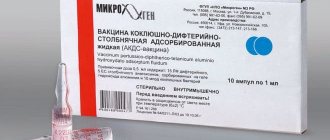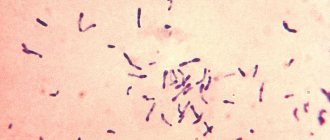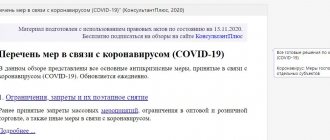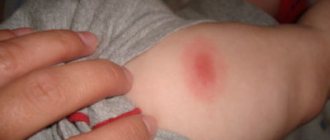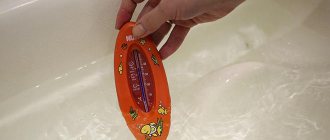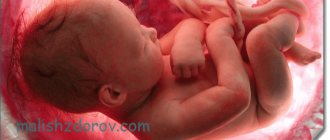Compound
Adsorbed liquid DPT vaccine is a combined preparation that contains a suspension of killed microbial cells of Bordetella pertussis at a concentration of 20 billion/ml, 30 flocculating units of Anatoxinum diphthericum and 10 anatoxin-binding units of Anatoxinum tetanicum.
One vaccination dose, which is 0.5 ml, contains at least 30 IU (international immunizing units) of Anatoxinum diphthericum, 40 or 60 IU of Anatoxinum tetanicum, 4 IU (international protective units) of pertussis vaccine.
The DPT vaccine contains thiomersal (merthiolate) as a preservative. The concentration of the substance is 0.01%.
Pharmacodynamics and pharmacokinetics
DTP vaccination - what is it? Wikipedia provides the following explanation of DPT: an adsorbed vaccine for the prevention of whooping cough , tetanus and diphtheria , consisting of killed microbial cells of the whooping cough bacillus and purified diphtheria (Anatoxinum diphthericum) and tetanus (Anatoxinum tetanicum) toxoids sorbed on aluminum hydroxide .
Vaccination in accordance with the approved vaccination schedule contributes to the formation of specific immunity against diphtheria (Diphtheria), tetanus (Tetanus), and whooping cough (Pertussis) .
The pharmacokinetics of the drug have not been described.
Contraindications
Having found out from the doctor what the DPT vaccination is, parents will also learn that not everyone can get it.
Contraindications for vaccination are:
- progressive diseases neurological diseases;
- a history of indications that the child has had generalized seizures not associated with hyperthermia (afebrile seizures) ;
- a strong reaction in a child to the previous administration of the DTP vaccine, which was expressed in the form of hyperthermia in the first 2 days after injection of the drug (with a temperature of up to 40 degrees Celsius and above), the appearance of hyperemia with a diameter of more than 8 cm and swelling at the injection site;
- complications that developed after the previous administration of DTP vaccine;
- severe form of congenital or acquired immunodeficiency .
There are also a number of temporary contraindications for vaccination. Vaccination is delayed:
- if a child is diagnosed with an acute infectious disease (in this case, the decision on the timing of medical withdrawal should be decided by the doctor on an individual basis, taking into account the severity and duration of the disease);
- if a child’s chronic disease (vaccination is allowed no earlier than a month after all its manifestations disappear);
- if in the immediate environment of the child there are people infected with an acute infection;
- if the child has experienced stress in the recent past (divorce, moving, death of a relative, etc.).
On the day of vaccination, the child’s temperature must be measured. In addition, he is examined by a doctor. If there is any doubt about his condition, an in-depth examination is carried out, which involves blood and urine tests, and also, if necessary, the involvement of specialists for consultation.
Children for whom the drug is contraindicated can be immunized with ADS toxoid .
If the child has already been vaccinated twice, the course of immunization against tetanus and diphtheria is considered complete; if the child has only undergone primary vaccination, then further immunization is continued with ADS-M toxoid , which is administered to the child once, but not earlier than 3 months later.
In each of the described cases, revaccination should be carried out with ADS-M toxoid after 9-12 months.
If a complication appears after the 3rd vaccination with DPT suspension, for the first revaccination, which is carried out after 12-18 months, ADS-M toxoid . Subsequent booster vaccinations should be carried out at ages 7 and 14, and every 10 years thereafter. ADS-M toxoid is used as a vaccine preparation .
Komarovsky about DTP vaccination
For parents who are excited and worried, Evgeniy Olegovich Komarovsky advises to carefully read the information. Anti-vaxxers should reconsider their point of view.
Vaccination has helped save the lives of millions of children; it is the only reasonable choice for mothers and fathers in preventing terrible diseases for their children. After the DTP injection, the body will “get acquainted” with the components and learn to respond to them, so that when faced with a real disease, the immune system will be ready to defend itself.
Komarovsky recommends that parents be aware of what drug their children will be vaccinated with. There are no bad vaccines, but to comply with further systematization, injections of the same name are needed.
The doctor notes that DTP is a free vaccination, but if you wish, you can ask your pediatrician to give paid Infanrik or Tetrakok (available in pharmacies).
Side effects of DTP vaccination
Everyone knows what kind of DPT vaccine it is. The vaccine is very reactogenic - many vaccinated children may develop short-term local and general adverse reactions in the first 2 days after the injection - and therefore causes a lot of doubts and fears among mothers.
Consequences of DTP vaccination, which are the norm
Since the suspension is a substance that can cause an immune response in the body, the reaction to its administration can be quite strong. As stated above, reactions to vaccination can be both local and systemic, and it is very important to clearly separate normal phenomena from post-vaccination complications.
Vaccination reactions are considered to be side effects that appear in the first 3 days after the injection. All symptoms that appear after this period are not related to vaccination. The category of normal consequences after DTP vaccination includes slight soreness at the injection site (due to a violation of tissue integrity), redness and swelling of tissues.
polio vaccination is immediately given : after the child has been vaccinated against diphtheria , tetanus and whooping cough , an inoculation dose of live polio vaccine for oral administration (OPV) is instilled into his mouth or an inactivated injectable polio vaccine (IPV).
The reaction to the DTP vaccine and polio most often manifests itself with the same symptoms as the reaction to the DTP vaccine.
Describing the pros and cons of vaccines, Dr. Komarovsky notes that both OPV and IPV are equally effective and equally well tolerated by the child, however, in extremely rare cases (less than once in a million), the administration of OPV can cause the development of vaccine-associated virus (VAP). IPV contains killed viruses, so VAP is not possible after its administration.
Sometimes (very rarely) young children may experience symptoms of intestinal dysfunction of the polio vaccine , which will go away on their own after a few days.
In isolated cases, childhood polio may be complicated by incurrent diseases affecting the intestines and respiratory tract .
Vaccination is stressful for most children, so in addition to a mild immune response, which is expressed in the form of headaches, malaise, weakness, dizziness, digestive disorders and hyperthermia, the child may also experience behavioral reactions.
Quite often, after vaccination, a child cries (sometimes for a long time), becomes capricious, becomes restless and irritable, refuses to eat, does not sleep, or, on the contrary, sleeps longer than usual.
These phenomena are also considered normal.
Systemic reactions to vaccination
Systemic (general) adverse reactions reflect how the child’s body as a whole responded to the administration of the drug. As a rule, they appear several hours after the injection and are expressed in the form of refusal to eat, general malaise, and hyperthermia.
There are three degrees of reaction to vaccination: weak, moderate and severe.
A weak reaction is accompanied by a slight general malaise and an increase in temperature to 37-37.5°C. A temperature of 38°C after vaccination (plus/minus degrees) and a moderate deterioration in general health are a manifestation of a reaction of moderate severity.
A strong reaction to vaccination is considered to be a reaction that is accompanied by a significant rise in temperature (above 38.5°C) and a sharp deterioration in the child’s general condition (lethargy, refusal to eat, adynamia ).
If in the first 2 days after vaccination with DTP the temperature rises to 40°C, further immunization is carried out with the drug ADS (or ADS-M). This phenomenon is no longer normal, but is regarded as a complication after DTP vaccination.
There is no relationship between the severity of the body’s reaction to vaccination and the number of injections. It is believed that the reaction to the first injections of the drug is most pronounced. This is due to the fact that for the first time the child encounters whooping cough antigens and diphtheria and tetanus toxoids , and his immune system works more actively.
The reaction to the second vaccination and the reaction to the third vaccination in a healthy child are milder.
The reference books indicate that with each subsequent administration of the DTP vaccine, the body’s general reaction becomes less pronounced, and the local one, on the contrary, becomes more pronounced.
That is, after the first vaccination at 3 months and 2 vaccinations, which are administered one and a half months after the primary immunization, the child may have a fever, moodiness, etc., but the reaction to revaccination (4th dose of DPT vaccine) is accompanied by good general health, but decent compaction and soreness at the site of injection of the suspension.
How many days does the temperature last after DTP vaccination and what should be done to help the child?
After administration of the suspension, the temperature may remain elevated for up to 5 days. Since this reaction is so common, parents should prepare for it in advance.
In case of temperature rise Komarovsky E.O. recommends keeping powders at home for preparing a rehydration solution ( Humana , Regidron , Electrolyte , etc.), as well as Paracetamol in suppositories, Ibuprofen in syrup, Nimesulide in syrup or solution.
At temperatures up to 38°C (especially before bedtime), it is better to use suppositories; if the temperature rises above 38°C, liquid forms of antipyretic drugs should be given (primarily Ibuprofen ).
If the effect cannot be achieved with paracetamol and ibuprofen , the child should be given Nimesulide .
In addition to the use of antipyretics, it is also recommended to provide the child with plenty of fluids (it is considered optimal to use rehydration solutions ) and limit any food as much as possible.
Is it possible to go for a walk after DPT vaccination?
It is believed that after vaccination you should not go for a walk. Why? Yes, because, supposedly, a child after vaccination is more susceptible to infections.
What does Dr. Komarovsky say about this? Walk! If the child has normal temperature and health, walking in the fresh air will not harm him. But for a walk it is better to choose not a playground, but, for example, a park.
In general, after vaccination it is recommended to limit communication with other people. The child’s body forms immunity to serious diseases, so he should not come into contact with pathogenic microorganisms , the sources of which may be others.
Complications with DTP vaccination
Post-vaccination complications manifest themselves in the form of hyperthermia (temperature rises to 40°C or more), febrile and afebrile convulsions , episodes of piercing persistent monotonous crying/screaming, severe hypersensitivity reactions.
Given the likelihood of developing immediate hypersensitivity reactions, after administration of the suspension the child should be under medical supervision for half an hour.
The vaccination room must be provided with anti-shock therapy .
Research results indicate that the cause of complications after vaccination may be:
- non-compliance with vaccine storage rules;
- violation of the DTP vaccination technique;
- non-compliance with vaccination rules (including failure to clarify contraindications);
- individual characteristics (for example, severe allergies to the second and third injections of the vaccine);
- associated infection against which vaccination was carried out.
Compaction after DTP vaccination. What to do?
The thickening and redness after vaccination are associated with the presence of the adsorbent Al(OH)3 (aluminum hydroxide) in the suspension - a compound that increases the immunogenicity of the administered DTP vaccine and promotes the formation of the so-called vaccine depot.
The adsorbent provokes the development of an inflammatory process at the site of administration of the suspension, due to which a larger number of cells of the immune system can “get acquainted” with the vaccine preparation.
That is, if the vaccination site is red and swollen, but the swelling does not exceed 5 cm in diameter, the child is active and does not limit the movement of the leg, this is normal.
This allows you to create a focus of inflammation and attract to it a large number of lymphocytes , which will multiply and create a special population of T-lymphocytes - memory T-cells . These cells store data about antigens that acted previously and form a secondary immune response .
You should know that when an injection is given in the buttock, infiltrates occur more often than when the drug is injected into the thigh. The speed of resorption of the infiltrate also depends on where children are vaccinated: after an injection into the buttock, the swelling takes a little longer to go away.
There is no need to touch the injection site, knead it, rub it, or apply compresses, since these actions can provoke the development of an abscess .
Dr. Komarovsky writes that in cases where the appearance of a lump after DTP vaccination is not accompanied by a rise in body temperature and severe pain, the child generally feels well, and his activity and behavior are normal, parents have no reason to worry.
If there are still concerns, the doctor may advise the child to have an ultrasound of the soft tissues in the projection of the compaction. Typically, infiltrates take a long time to resolve, especially if the drug is injected into an area of the body with a small number of blood vessels .
Situations when the lump begins to bleed or fester require immediate consultation with a doctor.
Cough after DTP vaccination
Colds have no connection with vaccination. The effect of the vaccine is aimed at activating a certain part of the cells of the immune system , while colds are associated with the failure of other cells.
A child has the ability to produce T cells pathogenic microflora , which causes colds, is formed no earlier than 5 years.
Dr. Komarovsky claims that colds and coughs after vaccination are atypical reactions to the administration of a vaccine drug, and most often they are the result of a violation of the basic rules of child care (including incorrect actions of parents immediately after vaccination) or the addition of an additional infection (most often ARVI ) against the background of “busy” immunity.
Rash after vaccination
Rashes after vaccination sometimes appear directly on the area of the skin next to the injection site, and sometimes on the entire surface of the body.
For some children, this may be a normal reaction to vaccination, and all its manifestations disappear on their own, without requiring treatment.
However, if the child is prone to allergies , it is recommended to seek advice from a specialist who will help determine whether the rash is caused by the administration of the DPT vaccine or an allergy . In addition, quite often the appearance of a rash is associated with errors in the child’s nutrition.
If a child has allergic disorders , then he is given Suprastin before vaccination. to start taking an antihistamine 2 days before vaccination and in a maintenance dosage. Suprastin is considered the most powerful in suppressing allergies , however, this drug can cause adverse reactions (including increased drowsiness).
If necessary, the drug continues to be given on the day of vaccination and for another 2 days after it.
Child limps after vaccination
Lameness after vaccination is associated with injections that are given in the thigh muscle. Since the child’s muscle mass is not yet sufficiently developed, the drug is absorbed rather slowly, which causes some pain when walking and stepping on the leg.
To help the child recover faster, he is given a massage and provided with normal physical activity.
If a child refuses to step on his feet or walk at all, it is recommended to lay him on the bed and do exercises with his legs. Water procedures and vigorous rubbing with a towel soaked in warm water can be no less useful.
As a rule, lameness goes away within a week at most.
Swollen leg after vaccination
Swelling of the leg is most often a consequence of DPT revaccination (local reactions after administration of the 4th dose of the vaccine usually occur violently). If the swelling is severe and the leg is hot, it is recommended to show the child to the surgeon.
The doctor may recommend the use of Traumeel S , Fenistil-gel or alcohol compresses.
Who should not do DPT?
DTP is one of the vaccines that is difficult to tolerate in childhood. And if there have been no reactions to vaccinations before, then it can cause side effects. To avoid unwanted consequences from DTP vaccination, Komarovsky advises paying attention to the reasons why vaccination should be canceled.
The reasons may be temporary, such as:
- Colds.
- Infectious diseases.
- Increased body temperature.
- Exacerbation of chronic diseases.
In such cases, it is necessary to cure the child, and only two weeks after complete recovery can DPT be administered.
DTP vaccination cannot be done if you have the following diseases:
- Deviations in the functioning of the nervous system that progress.
- Previous vaccinations were very difficult to tolerate.
- The child had a history of seizures.
- Previous vaccinations caused febrile seizures.
- Immunodeficiency.
- Particular sensitivity to the components of the vaccine or intolerance to them.
If your child has any disease, or you are afraid that the DTP vaccine will cause unwanted consequences, you should consult a doctor. You may be prescribed a vaccine that does not contain pertussis toxoids, since these are the ones that can cause adverse reactions.
Vaccination may also be delayed if the child has:
- Diathesis.
- Little weight.
- Premature baby.
- Encephalopathy.
In these conditions, vaccination is possible, but preparation for DTP vaccination, Komarovsky especially notes, should consist of stabilizing the health status. It is best to use an acellular vaccine with a high degree of purification for such children.
Instructions for use of the vaccine
What is the DTP vaccine for and where is the injection given?
Many parents, along with what the DPT vaccine is for, are also interested in the question “where is the injection given?” The adsorbed DTP vaccine is administered exclusively intramuscularly. Previously, the injection was given into the gluteal muscle, but the structure of the child’s buttocks is such that there is a fairly large layer of fatty tissue there.
The penetration of the suspension into adipose tissue provokes the formation of a long-absorbing infiltrate and reduces the effectiveness of vaccination.
Currently, the vaccine preparation is injected into the anterior outer part of the child's thigh. Children over one and a half years old are vaccinated in the deltoid muscle (in the upper third of the shoulder). A child over 7 years old is allowed to inject the suspension under the shoulder blade (in this case, special needles are used for hypodermic injections).
How many times is DTP vaccination given?
The primary immunization regimen involves the administration of 3 doses of the vaccine, which are administered to the child in the first year of life. A healthy child under 12 months of age who has no contraindications to vaccination is administered the DTP vaccine at 3, 4.5 and 6 months (the interval between injections must be at least 30 days). Next, revaccination is carried out.
It is unacceptable to shorten the intervals between vaccine administrations.
Timing of DPT revaccination
What is revaccination and how many times is revaccination done? Revaccination is an event whose purpose is to maintain the immunity that has developed after previous vaccinations.
DPT revaccination is carried out once every 1.5 years. If the timing of vaccination has been changed, 12-13 months after the child receives the third vaccine dose of the drug.
Preparing for vaccination
There are several recommendations on how to prepare for vaccination so that your child can handle it as easily as possible.
Mandatory conditions for successful immunization are the child’s good health (including on the day of vaccination), high quality of the vaccine preparation and compliance with the vaccination conditions.
Komarovsky recommends before vaccination:
- reduce the load on the child’s intestines (that is, limit the amount and concentration of food the child receives);
- make sure that the child has a bowel movement within 24 hours before vaccination (if there is none, before going to the clinic, you should give the baby a glycerin suppository or do a cleansing enema);
- Do not give vitamin D ( vitamin D is responsible for regulating Ca metabolism in the body, and Ca metabolism disorders underlie the development of allergic reactions; therefore, even a slight overdose of vitamin D can cause the child to tolerate vaccination less well);
- to reduce the risk of allergic reactions , 3 days before the vaccine is administered (and for 3 days after it), give the child calcium gluconate (1 tablet per day);
- if the pediatrician insists on taking antihistamines , they should be taken in combination with calcium gluconate ;
- do not feed an hour before vaccination and as long as possible after it (it’s good if you can wait 3 hours);
- avoid fluid deficiency (including not dressing the child too warmly so that he does not sweat or lose fluid before vaccination);
- Do not introduce new products for several days.
How to behave if adverse reactions occur
Mild adverse reactions are still possible. Since the DTP vaccine is considered the most difficult for the body, especially if the child previously had negative reactions to vaccinations. What to do if side effects occur after receiving the DPT vaccine:
- Temperature. Komarovsky recommends constantly monitoring it. You shouldn’t wait until 38, you should give an antipyretic as soon as it starts to rise.
- If swelling or redness appears at the injection site, the child must be shown to a doctor. It is possible that the drug did not enter the muscle, but the subcutaneous fatty tissue, which may cause swelling and hardening. In any case, a doctor’s consultation is necessary to alleviate the child’s condition and eliminate possible complications. If it's just minor redness, it will go away within 7 days and you don't need to do anything.
In order to avoid side effects, you should take seriously the preparation of your child for vaccination. More on this later.
Instructions for DTP
The DPT vaccine is used to immunize children from 3 months to 4 years of age. If a child has had whooping cough , ADS toxoid .
A single dose of suspension is 0.5 ml. Before administering the suspension, the ampoule should be heated to body temperature (holding it in the hand) and shaken thoroughly to form a homogeneous suspension.
If it is necessary to increase the interval before the next vaccination, vaccination should be carried out as soon as possible, as soon as the child’s health condition allows.
If a child under 4 years of age has not received the 4th dose of the DPT vaccine, revaccination is performed with ADS-toxoid (intended for children aged 4 to 6 years) or ADS-M-toxoid (intended for children over 6 years old).
special instructions
How does DTP stand for?
Parents of young children who are faced with vaccination for the first time quite often have questions “What is DTP?” In international nomenclature, the vaccine is known as DTP. Decoding DTP (DTP) is quite simple: adsorbed vaccine for the prevention of Diphtheria (diphtheria), Tetanus (tetanus), Pertussis (whooping cough) .
What kinds of vaccines are there and which vaccine is better?
The DTP vaccine is used to prevent diphtheria, whooping cough and tetanus in children under four years of age. Today, in clinics and vaccination centers, along with the domestic DTP drug, more modern imported vaccines are often used.
Some of them, like DTP, are three-component, while others allow immunization, including against polio, Haemophilus influenzae and hepatitis .
For example, the drug Pentaxim is DTP in combination with inactivated polio viruses (IPV) types 1-3 and HIB infection; Tetrakok is DTP in combination with IPV; Tritanrix-HB is a DPT in combination with recombinant surface antigen of the hepatitis B virus .
As an alternative to DTP, the doctor may advise the child's parents to introduce a foreign analogue registered in the country - for example, Bubo-Kok , Tetrakok or Infanrix .
the pertussis component in DTP is present in an undigested form (the suspension contains inactivated (killed) pertussis bacillus ), the drug belongs to the category of whole-cell vaccines .
Undivided microbial cells represent a whole set of substances foreign to the child’s body, so the reaction to the DTP vaccine often occurs quite violently (as well as to the drug Tetrakok , which is also a whole-cell vaccine ).
Unlike these products, in the Infanrix and Pentaxim the pertussis component is represented only by the main elements (fragments) of the microbe Bordetella pertussis.
These drugs induce the same level of immunity as their whole-cell analogues, however, they produce significantly fewer reactions.
Therefore, if parents have the opportunity to choose which is better to vaccinate - DTP or Infanrix , DTP or Pentaxim - it is better to give preference to a foreign drug.
Additional recommendations for vaccination
Persistent symptoms of an allergic disease are not contraindications to vaccination. DTP injection is permitted against the background of appropriate therapy.
Children whose weight at birth did not exceed 2 kg, with normal psychomotor and physical development, are vaccinated according to the standard schedule. Low body weight is not a reason to delay immunization.
It is prohibited to administer the suspension:
- from ampoules with no markings;
- from ampoules with damaged integrity;
- if the drug is expired or stored incorrectly;
- if the drug has changed its physical properties (if flakes that do not develop have appeared in it or it has changed color).
The vaccination procedure (including opening of ampoules) is carried out in strict compliance with the rules of asepsis and antiseptics. After opening the ampoule, the unused drug must be disposed of.
The administration of the vaccine must be registered in the established accounting forms, indicating the date of administration, the expiration date of the suspension, the batch number, the manufacturing company, and the characteristics of the reaction to the administration.
Is it possible to wet the DPT injection site?
When a DPT injection is given, parents are warned that the child should not be bathed for some time. On Dr. Komarovsky’s website it is written that one should refrain from bathing only on the day of vaccination (theoretically, it is considered possible for a child to be infected through an injection wound), after which the child is bathed as usual.
If after vaccination parents wet the injection site, it’s not a big deal.
If the temperature rises, bathing is replaced by wiping with wet wipes.
How to prepare a child for DTP vaccination
Komarovsky gives some simple and necessary advice:
- Show the child to a pediatrician, who should examine him and correctly assess his condition. In other words, confirm that the child is healthy.
- If your child has allergies, an antihistamine should be given 3 days before the vaccination. Before doing this, you should consult your doctor about the drug and its dosage.
- It is best to visit a neurologist and take urine and blood tests. Especially if the child suffered from any illness before this.
- You should not overfeed your child on the day of vaccination.
- If there is a suspicion that the child may get sick, or if someone in the family is sick, you should postpone vaccination.
- The vaccine must be of high quality and administered correctly.
Analogs
Matches by level 4 ATX code:
SolkoTrichovak
Ismizhen
Anatoxin Staphylococcal
DTP-M , DTP-Hep-B (DTP vaccination and hepatitis together), Infanrix (including Hexa , Penta, IPV), Bubo-Kok , Pentaxim , Bubo-M , Tetraxim .
Reviews about DPT
Reviews about the DPT vaccine differ significantly depending on who leaves them: opponents of vaccination or people who are its supporters.
Assessing the reviews of the latter, we can conclude that although the DPT vaccination is a serious test for a child (the vaccine is very reactogenic, and its administration is associated with certain risks), it is still the only effective way to prevent dangerous infectious diseases.
To reduce the likelihood of adverse reactions, DPT is now often replaced with imported vaccines Infanrix or Pentaxim , which are much easier to tolerate by children.
Which vaccine to choose
Types of vaccines
- Most are divided by the presence of agents: live and inactivated.
- By the number of infections it protects against: from 1 to 5.
- By components: whole-cell and cell-free.
- By viral load: high or low.
- According to the frequency of reactions: frequent general and local rare.
- Cost: free, paid.
Comparison
Domestic: inactivated, from 1 to 5 infections, whole cell, with a high load and frequent local reactions, free.
Foreign: inactivated, up to 5 pathogens, cell-free, with low load and rare side effects, paid.
